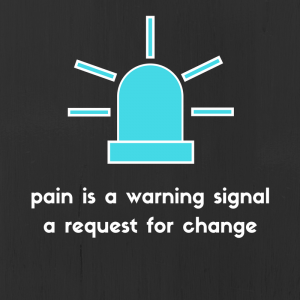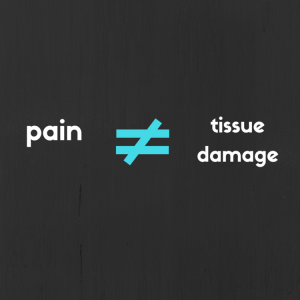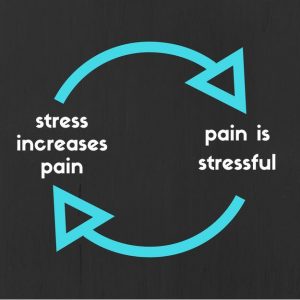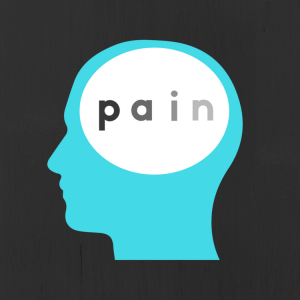January 22nd, 2018
Ever wonder why a broken bone doesn’t hurt right away? How about why the sign of a heart attack is pain in the left arm? ¬†Pain is more than being pinched and saying “OW!” ¬†It’s complex and will present differently for different people at different times, even in the same injury. ¬†By understanding how pain works, we can better manage it with less stress.

Pain is a Warning Signal
Did you know that we don‚Äôt actually have pain receptors? What we do have are called nociceptors. Unlike other regular touch receptors, nociceptors require a much higher stimulus to send signals to the brain. The nociceptors job is to yell up to the brain, ‚ÄúHey, check this out! Is this okay?‚ÄĚ Once our brain receives a signal from nociceptors, it decides whether or not the signal is threatening. If the brain thinks the signal is a threat, pain is produced. If the brain thinks the signal is not threatening, pain is not produced.

Pain Does Not Equal Tissue Damage
“Pain is an alarm, not a damage indicator.” (Lehman) ¬†A great example of this is sudden low back pain. ¬†You may have experienced this. ¬†You go down to pick something up (maybe it‚Äôs something small like a pencil), and WHOOPS! Your back ‚Äúgoes out,‚ÄĚ and it‚Äôs excruciating to straighten up. ¬†Did you rupture a disc or pull a muscle doing such a simple task? ¬†Not likely. ¬†Your spine is an important structure. For some reason your brain perceived that movement as threatening, and tightened up the muscles in your back to protect you.

Pain is Context Dependent and Multi-factorial
At airports they say to report suspicious packages. ¬†It’s up to airport security to determine how to respond. ¬†Before 9/11 a suspicions package would probably be treated as less of a threat. Nowadays, something like that is taken extremely serious, because our context is different. ¬†Pain works in the same way. ¬†A previous injury may lower your threshold for having pain.
When deciding whether to send a pain signal, your brain takes in all pertinent information. ¬†The amount of sleep you’re running on, your level of stress, your history of pain will all contribute to your current pain state. ¬†This also means that pain can change from day to day without any more or less tissue damage. This should be reassuring. ¬†People dealing with an injury will often get discouraged when they feel worse than the day before. ¬†This is not necessarily a set-back. ¬†Perhaps that person got less sleep, is less hydrated, or more stressed than they were yesterday. ¬†Since pain is multi-factorial, it’s important to consider more than just the health of the painful tissue.
It’s important to recognize that pain is a request for change, but it’s just as important not to let it stress you out.

Pain Can Be Learned and Unlearned
The good news is the brain is plastic, meaning it can change. It can unlearn pain by performing once threatening movements in a safe environment.  That is why we find movement so valuable at TruMotion. We are training the brain!
Pain is Not All In Your Head
Don’t let the above info make you think pain is imagined. ¬†Pain is all in your head the same way hunger is all in your head. ¬†Sure signals from your stomach will trigger the feeling of hunger, but the site of rotten trash will quickly block those signals. Pain works in the same way. It‚Äôs physical AND psychological.
“You Are Not Your MRI or X-Ray”¬†-Lehman
MRI and x-ray have bad track records of identifying pain. ¬†It’s common to have rotator cuff tears or bulging discs show up on imaging in people who don’t have any pain. ¬†These types of imaging are great for identifying serious pathology like cancer, but pain is not something that can be be reduced to an image. ¬†Remember, it’s multi-factorial!
Management Strategies
- Pain is a warning signal meant to protect you, not an indication that you’re damaged.
- Pain is context dependent, so changing your context can help provide relief.
- Get 8 hours of sleep.
- Do things you enjoy to balance out things that may stress you out.
- Hydrate.
- Eat clean and avoid inflammatory foods.
- A skilled chiropractor can help you find ways to move around your pain so your brain can unlearn it.
- For the most part, don’t sweat MRI or x-ray findings.
This is a massive topic that is not done justice in a single blog post.  If you are struggling with pain, give us a call and check out these two excellent (free) resources you should check out:





